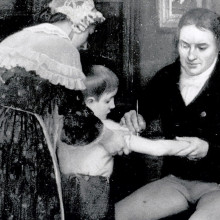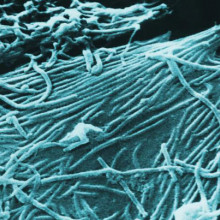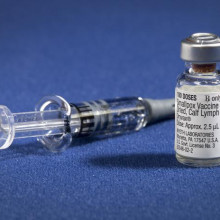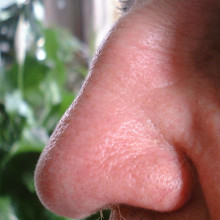The A - Zika of viruses: Preventing Pandemics
With infectious diseases wiping out millions each year, we look at how we can predict pandemics, whether scientists should be allowed to engineer super viruses, and how war and politics could prevent us from winning the fight against polio. Plus, news of how laughing gas could prevent PTSD, a breakthrough in soft-robotics and why skipping sleep could give you the munchies.
In this episode

00:51 - Could laughing gas prevent PTSD?
Could laughing gas prevent PTSD?
with Dr Ravi Das, University College
People who go through extreme and harrowing events often develop a  condition called post traumatic stress disorder, or PTSD. Sufferers describe recurrent intrusive flashbacks of the event that can sometimes leave them feeling suicidal. But might a dose of laughing gas, nitrous oxide, given after a traumatic event, lower the risk of PTSD? Naked Scientist Georgia Mills spoke with UCL's Ravi Das who has evidence to suggest that it might...
condition called post traumatic stress disorder, or PTSD. Sufferers describe recurrent intrusive flashbacks of the event that can sometimes leave them feeling suicidal. But might a dose of laughing gas, nitrous oxide, given after a traumatic event, lower the risk of PTSD? Naked Scientist Georgia Mills spoke with UCL's Ravi Das who has evidence to suggest that it might...
Ravi - We were specifically looking at nitrous oxide because we know that one of the way it acts is at a certain brain receptor that's critical in memory formation, and one of the main things that we think contributes to PTSD is the formation of these kind of traumatic memories that can resurface and cause these intrusive thoughts, and images, and flashbacks which are kind of the cardinal symptom of PTSD. People can have the experience of being back at the time of the trauma, kind of context and situation free and re-experiencing that event. So it's really unpleasant.
Georgia - How did you test this? I'm guessing you couldn't actually give people PTSD? That sounds slightly unethical.
Ravi - Yes, that wouldn't have been a real hit with the ethics board. So we've got a kind of laboratory model of a very weak form of PTSD, if you will, and it's used by quite a few labs. Basically, it involves showing healthy volunteers a really unpleasant film and what you see is, over the course of a week if you get people to keep track, they'll experience these involuntary memories about aspects of the film which tend to be images of some of the nasty things that have happened, and they'll just pop into people's minds in an involuntary way and those are what we call intrusive memories. So we show people this film and then measure over the following week how many times they're experiencing these. We gave people either nitrous oxide gas, which is the same form that you'd get in the NHS (it's a product called entonox), so it's mixed with oxygen and it's a lot safer than the gas canisters that people use recreationally. So they got that or a matched kind of normal air from a canister and they breath that for half an hour and then we assessed for the following week of how many of these intrusive thoughts they had.
Georgia - Now, I've not seen this film but I did look it up on line and I read a couple of reviews, and one of them called it cinematic torture. They said "I've yet to meet anyone who's not been deeply affected by this movie if they were brave enough, or stupid enough, to watch it." Your poor test subjects...
Ravi - There's a problem with doing any studies that try to model something that's inherently unpleasant in that you have to, within ethical bounds, give people something quite unpleasant to do. Yes, I did feel terrible for the participants while they were having to watch it.
Georgia - Did you watch it?
Ravi - Yes, because much of the time you were sitting in the room with the participants awkwardly knowing what they were having to go through. Yes, I have to say I agree with some of the reviewers - it is one of the worst things I've ever seen.
Georgia - And with the participants who got either this nitrous oxide mix or the control, which was air, what difference did you find with their feelings about the film?
Ravi - What we hypothesised was that given this receptor that nitrous oxide blocks is really important in the shift, the transfer of information from short term memory to long term memory. So we thought that it would prevent some of those memories stabilising and weaken them and what we saw is that by the second day, the people in the nitrous oxide group had greatly reduced in their number of intrusive memories about the film but the normal air group hadn't, and it wasn't until about four days later that we saw a significant reduction in those that had the normal air. But it was basically straight after sleeping in the nitrous oxide group and we know that sleep is also really critical for this kind of stabalisation of memories into the long term. So nitrous oxide seems to have interfered with that kind of sleep dependent stabalisation of the memories.
Georgia - Has nitrous oxide been tested in the field? Do we know if this works in the real life events that might cause PTSD?
Ravi - It's really interesting because it is used on the NHS currently in paramedic teams as a pre-hospital anaesthetic so it might be having unforeseen consequences already for people who are receiving it. They might have already gone through a traumatic experience; we don't know currently whether that's subsequently affecting their memories. And one of things we're interested in doing is looking to see if we can start monitoring situations where people have received it before being admitted to hospital versus people who haven't. But in terms of, I'm thinking maybe military application, all this is dependent, obviously, on our results being replicated in a clinical example but, because it is easy to administer, it's portable, it's very safe, and once people stop breathing it it stops having an effect very quickly. I don't see why it couldn't be miniaturised and used as a first line prophylactic type of intervention following traumatic events - yes.

06:14 - Breakthrough in soft robotics
Breakthrough in soft robotics
with Professor Robert Shepherd, Cornell University
A recipe for a soft robotic skin that's sensitive to touch and has the ability to change colour, like an octopus, has been developed by engineers in the US. This could pave the way for blushing robots and 3D phone displays. Rob Shepherd, who led the group behind the invention, told the group how it came about...
colour, like an octopus, has been developed by engineers in the US. This could pave the way for blushing robots and 3D phone displays. Rob Shepherd, who led the group behind the invention, told the group how it came about...
Rob - There's a field now called soft robotics and these machines are capable of working around humans safely, which is very important. But there are some things they can't do since their bodies are required to stretch to large degrees - we need electronics that can stretch with them. Some of the same students that were in my lab were taking a course on engineering with soft materials where I tasked them with coming up with a new device and they, on their own, decided it would be great to impart light emitting particles into these sensors. So now, they created a device that can sense touch and also emit light in red, green or blue.
Chris - Wow. So how does this work - talk us through effectively what you have made and how it actually does that?
Rob - So this material is rubber. There are two different kinds of rubber; there's one that doesn't conduct electricity and another one that does conduct current. And so, by layering sheets of these, we can create the sensors and the light emitting displays, and because it's all rubber, it stretches like rubber and it's soft like rubber.
Chris - So how do you make the rubber conduct electricity?
Rob - So this technique, actually, was developed a couple of years ago at Harvard. What they did is they put salt water inside of a rubber and we took that material and layered it with an insulating material and that composite is what gives us this new ability.
Chris - How does that architecture then - layers of a conducting rubber and a non-conducting - an insulating rubber - turn into something which a) can detect pressure and b) also make light?
Rob - Well what you've just described, we call a capacitor, and when we can stretch the capacitor, we change the distance between the plates of the capacitor. That capacitor's change results in a signal that we detect.
Chris - How do you get the light out though?
Rob - Well, in the insulating rubber we put light emitting particles and when we apply voltage across the plates, they emit light. One of the really cool features about the work is that it's made by casting a liquid and turning it into a rubber. Depending on how we cast it, we can have as many pixels as we like.
Chris - Then the application of this would be that if I built a robert with a human hand like structure, it would know when it was curving that surface around my hand to shake my hand. It would know how much it was stretching and, therefore, how much force it was applying to my hand so you wouldn't be in that ignominious situation where you've made a beautiful human-like robot that's capable of taking my arm off?
Rob - That's right. Since one of the major benefits of soft robots is that they can interact with humans safely. It's important to also let them feel what they are interacting with and that's what this does.
Chris - How easy is that to achieve thought? You've done this in a small piece of material, but could you extrapolate this to a whole robot?
Rob - That's exactly what we're doing right now. So our next step is to put this skin onto a larger, more functional robot and test it out and we believe it's very possible.
Chris - And now that you can get this beautiful lighting effect for free. I mean lots of people wear makeup; your robot could almost have light generated, self-made makeup, couldn't it, so it could even blush. What's the application of being able to put the light in there as well? Why is that helpful?
Rob - Well there's a few reasons. We make a point in the paper; there's two things this technology enables. One are robots that can change their colour and another are displays that change their shape and you pointed actually to a very important point - make-up is not useless. The ability to create an emotional response with the people you are interacting with is important and we believe, as robots work with people more, their ability to communicate information visually is very important and that's what we can do with this technology.

10:56 - Myth: Do cats always land on their feet?
Myth: Do cats always land on their feet?
with Dr Kat Arney, The Naked Scientists
For this week's Mythconception, Kat Arney has been tackling a piece of scientific dogma... about cats.
dogma... about cats.
Kat -At the risk of offending any of our cat-loving listeners, I'm much more of a dog person, so this week I've been finding out what happens when you throw a cat out of a window. Before you complain, no animals were harmed during the making of this radio show. But I did want to discover if it's true that cats always land on their feet, no matter how far they fall, and that this enables them to survive falls from incredible heights.
As anyone who has a cat will know, they tend to have no problem with heights, and many of them love climbing all over the place. But this does mean that they can get into trouble, chasing a bird or bee through an open window, or off a balcony or rooftop. And although many of them do land on their feet unscathed, they can sustain serious injuries and even die as a result, especially if falling more than a few floors. So let's first take a look at what happens when they do make a successful four-footed touchdown - and then what goes wrong when they don't.
Cats - along with other animals including rats and rabbits - have something called an air-righting reflex. This means that when they sense they're falling and they're the wrong way up, they will attempt to flip over in the air in the hope of landing feet first. And because cats have an unusually flexible spine and don't really have collarbones, they're able to do this really well. It happens like this: first, they bend in the middle, so the front half of their body twists in the opposite direction to the back. Next, they tuck in their front legs, to make their front half twist further, and stick out their back legs so their back half twists less. That gets the front half the right way up - front feet underneath, head on top. Then they switch round, tucking in their back legs and sticking out their front legs, so the back half flips so their feet face the floor.
The cat righting reflex starts kicking in from when a kitten is around 3 or 4 weeks old, and by 6 to 7 weeks they've got it nailed, ensuring a safe landing from a height of several stories. There are a few things that can interfere with this though, and the first is falling from an insufficient height to execute their backflip move - they need to drop at least half a metre or so to have enough room to manoeuvre. Experiments with rats have shown that alcohol interferes with the righting reflex by messing about with the balance-sensing mechanisms in the ear. So if you got your cat drunk and threw it out of the window, it might struggle to land neatly - please don't try this at home!
The other big question is - do cats always manage to land on their feet from any height, and do they always escape unscathed? The answers to this depend on how far it's falling, and what it lands on. Cats can certainly break bones by landing on concrete or other hard surfaces from heights of more than about ten metres - so-called 'high rise syndrome' - as they can't absorb the shock, regardless of landing on their feet or not. But if they fall from more than about five stories, something interesting happens - they hit what's known as terminal velocity, when they're falling as fast as gravity will let them. There's some suggestion that in this situation, once a cat has got itself the right way up, it will relax and spread out, like a parachute, which might help to reduce injuries when it hits rock bottom.
Intriguingly, a study in the 1980s looking at vet records of cats brought in after falls suggested 90% of animals falling from buildings survived - and in fact their chances of surviving with fewer injuries were actually better if they fell from six or more stories than from lower heights, suggesting that the kitty parachute might be true.
Of course, there's an obvious alternative explanation - animals falling from greater heights might be much more likely to be dead on arrival so wouldn't be taken to the vet, skewing the statistics. And a more recent study showed that the further it falls, the more likely your moggy is to sustain serious injuries.
So while it's true that cats can - usually- land on their feet, they don't always make it out unscathed, and in some cases reach the end of their (also mythical) nine lives in a rather messy and tragic manner. Probably best to keep the windows shut if you want to keep your kitty in one piece.

14:50 - Poor sleep could give you the munchies
Poor sleep could give you the munchies
with Dr Erin Hanlon, University of Chicago
Have you been getting your forty winks? Because researchers have revealed this week that lack of sleep actually gives you the metabolic equivalent of the marijuana munchies, which could lead to unnecessary binge-eating. Erin Hanlon explained her research to Chris Smith...
Erin - There's an association between insufficient sleep, or short sleep, and the increased risk of obesity and there's been some carefully controlled laboratory studies that have shown that when people are sleep restricted, they are reporting feeling hungrier and having a stronger appetite, most specifically for high carbohydrate and high fat foods. So we wanted to examine what might be causing this increase in appetite and further help to explain the current association with the increased risk of obesity following sleep restriction.
Chris - And just to be clear, the increased appetite that's measured in these people; that's not just because if you're awake longer, you're functioning for longer, you need more energy, therefore you compensate by eating more?
Erin - Correct. So the energy need of being awake longer is actually quite modest and studies have started to show that people are consuming more calories than are actually needed to maintain wakefulness.
Chris - So something else is going on, driving people who are in a state of sleep deprivation, to overeat?
Erin - Exactly. That's exactly it...
Chris - But we don't know what it is, as yet?
Erin - Right. Well we're starting to kind of tease those things apart. It's probably a lot of things working in concert and our current study is adding to this growing literature and suggest one pathway by which this might be occurring.
Chris - What did you do to explore it and what is that pathway?
Erin - Right. So we brought people into the laboratory; we had then sleep either eight and a half hours a night or four and a half hours a night, and we examined a system that is involved in many areas. It's involved in stress, the immune system, pain, reward and specifically reward driven eating or hedonic eating. So we explored this system, and it's actually called the endocannabinoid system. Following normal sleep, we found that blood concentrations of lipids that are involved in this system are low overnight and high during the day. When these individuals were sleep restricted, during the day those levels were even higher.
Chris - You are hypothesising then that those are driving the increased appetite that these people display?
Erin - That's what we think, because the endocannabinoid system has been known to be involved involved in overeating, and actually overeating highly palatable foods. So it's been thought that this system was involved in brain reward pathways and might affect eating behaviour via reward circuitry. So seeing this increase in blood concentrations suggests that this system might be overactive following a state of sleep restriction.
Chris - In other words, sleep restriction could be mimicking the marijuana munchies. The idea that people who use cannabis also tend to report getting hungrier, and eating more, and a tendency towards being overweight.
Erin - Exactly. So marijuana activates the endocannabinoid system as well. So we think that perhaps sleep restriction, just like marijuana usage, is activating the endocannabinoid system to cause overeating and overeating of highly palatable, rewarding foods.
Chris - Why?
Erin - I don't know.
Chris - What do we think the benefit of that is? Is that just because, if you are sleep deprived you're more likely to be a bit less motivated, a bit more tired, a bit sluggish, therefore making sure you feel like you want to keep eating and stay at the top of your energy game, means you're less likely to become someone else's lunch in our evolutionary history? Is that the idea?
Erin - It was probably protective at some point in a state of feast or famine, when you had to overeat to have energy stores for other times when you might not have access to food, but it's become a little bit maladaptive lately.
Chris - Where does this leave us then? What do we have to ask now, and does this help us to solve the problem for people who do gain weight because they're not getting enough sleep?
Erin - I don't think it will actually solve the problem but I hope it draws attention to the fact that sleep restriction and sleep deficiency is associated with a lot of negative outcomes and increased feeding just happens to be one of them. So, hopefully, this draws attention to the fact that we need to think of adequate sleep as an important aspect of maintaining good health and just as a byproduct of the day.

19:40 - Happy Birthday: Britain's longest study
Happy Birthday: Britain's longest study
with Diana Kuh, University of College London & Tony Miles, study participant
Most scientific studies last for a matter of hours or days. But there's one very  important medical study that is probably the longest running of them all and this week it celebrated its 70th birthday, along with the surviving study participants - all 3000 of them from around the UK. They've been sharing their health and lifestyle data, across their lifetimes, with a team of MRC scientists at University College London. Connie Orbach has been hearing what the study has achieved and began by dropping in on one of the study participants, Tony Miles who lives in Cambridgeshire...
important medical study that is probably the longest running of them all and this week it celebrated its 70th birthday, along with the surviving study participants - all 3000 of them from around the UK. They've been sharing their health and lifestyle data, across their lifetimes, with a team of MRC scientists at University College London. Connie Orbach has been hearing what the study has achieved and began by dropping in on one of the study participants, Tony Miles who lives in Cambridgeshire...
Tony - One of the female participants had a boyfriend who became her fiance, I think, and she had a load of data from the survey ARRIVE and was answering the questionnaire and stuff like that. And he approached her and said "why are you answering all these questions. These are all nosy parker things" and threw everything in the bin. But she thought, if he thinks like that he's not going to be the husband for me and ditched him, and thanks the study for not marrying the wrong bloke.
Connie - And she still thinks it's a good decision then?
Tony - Of course.
Connie - They've had wider reaching effects than maybe even they realised would happen. Relationships aside, this study has had some really important impacts since it was established in 1946, especially as it was the first ever one. Diana Khu, Director of the cohort study a.k.a. the MRC National Survey of Health & Development at UCL explains...
Diana - Britain really led the way - this was the first of the nation birth cohorts. We're known around the world for these cohort studies and, over the years, there have been other countries who have also started off birth cohort studies in Europe, in America, and now in quite a few of the low income countries, and we learn a lot by comparing across these studies. So you can see whether findings in one cohort are actually due to find the same. Can you replicate those because that's very important for policy, for the impact of the information if we can show that we find the same associations across these studies.
Connie - You explained how the very initial study fed into the foundation of the NHS, especially in maternity. What are the other big findings over the years that's really affected our policy - the way that Britain works?
Diana - Well let me pick just two. When they were children they did quite detailed cognitive tests so we knew when they were ageD eight, for example, how well they were doing cognitively. Then James Douglas followed them up - did they get through the 11 plus, did they go on to get educational qualifications, and such like. And children who were, apparently, very cognitively able but came from poorer backgrounds had much less chance of benefiting from their cognition, if you like, in later life and getting into good jobs, or schools, or whatever, and that was called the register of talent. It's really important that we invest in children in their health and education because they are the future generation. So a lot of the study findings went into commissions looking at policy reform for education in the 60s and 70s.
Now we're very interested in ageing and we can identify people who may be having an accelerated ageing process earlier. People who may be more susceptible to certain types of ageing trajectories and I think we need to be making sure we get in early and not waiting until people already have a lot of chronic diseases, and problems, and functional decline. I think that's the future and our information is being used to help.
Connie - This study has clearly had far-reaching consequences but it's not just about the way it's changed public policy; it has also dramatically impacted the lives of people taking part. Here's Tony again...
Tony - The team are forever thankful. The research scientists have so much data and they use everything they've discovered in a wide-ranging way. We're a perfect group to see how well we've developed and now how well we are, and having them thank us all the time like that does make you think - Oh I'm glad I've done that; I'm glad I stayed in that study doing that.
Connie - Well happy birthday Tony and all the other participants - thank you all for your help. And, as a birthday present, it seems that the latest results have some good news for later life.
Diana - In the same group of people we did a wellbeing scale in their early 60s and have just repeated it. On average, people's wellbeing has been going up on all the different aspects that we ask about, and there is a group who we were particularly interested in who have actually had a significant increase in their wellbeing. When we spoke about that at the 70th birthday party, two study members shouted from the audience "retirement!"

25:18 - The story of smallpox
The story of smallpox
with Dr Mary Dobson, University of Cambridge
There's a disease dubbed the Angel of Death, which has wiped out millions  throughout history. Thankfully, it's also famous for becoming the first disease humanity ever managed to eradicate. Georgia Mills spoke to medical historian Mary Dobson to get the story of smallpox.
throughout history. Thankfully, it's also famous for becoming the first disease humanity ever managed to eradicate. Georgia Mills spoke to medical historian Mary Dobson to get the story of smallpox.
Georgia - I wanted to hear the story of how smallpox went from being one of the world's deadliest diseases to being one of sciences greatest success stories. So, I went to meet medical historian and author of the book "Murderous Contagion," Dr Mary Dobson at Cambridge University Farm to find out about this disease...
Mary - It really was a devastating disease. People would be covered in horrible pustules; they would be exceptionally painful; some would die from a hemorrhagic fever; probably a third of those who contracted smallpox would die; survivors could be pockmarked for the rest of their lives and, I think, an unknown, not often mentioned is blindness, so again, those who survived could be blind for life.
Georgia - With such a frightening prognosis, smallpox left a significant mark on history. British historian Lord Macaulay made this observation in the 1800s.
"The smallpox was always present, filling the churchyards with corpses, tormenting with constant fears all whom it had not yet stricken, leaving on those whose lives it had spared the hideous traces of its power: turning the babe into a changeling at which the mother shuddered, and making the eyes and cheeks of the betrothed maiden the objects of horror to the lover..."
It affected rich and poor alike, knowing no class boundaries. Ramses V, Abraham Lincoln and even Mozart all contracted smallpox, so how did people try and avoid this dreaded disease?
Mary - I think smallpox is an interesting case because people were aware that it was contagious, so prevention was one of trying to avoid being close to a contagious person. Bloodletting was the cure for almost everything in the old days, right up to the mid nineteenth century. It would have done very, very little good for anyone suffering from smallpox. So, not a lot that they could do but numerous old remedies are concocted...
Georgia - I think I read one that was powdered horse manure...
Mary - Yes, powdered horse manure is one of those good old fashioned remedies - anything from garlic to alcohol or herbs. Around the 10th century in China it was said that they removed scabs from the drying pustules of a smallpox patient, pounded them into powder and then blew a few grains into the nose of people who had not had the illness...
Georgia - Ewh...
Mary - Yes, and one of the things that amuses me is: up the right nostril for a boy and the left one for a girl...
Georgia - Of course...
Mary - Who knows why!
Georgia - This idea of infecting healthy people intentionally with small parts of the virus did actually work to some extent but what came next in the fight against smallpox changed everything - the vaccination. And it's at this point we meet a key player in the story - the humble cow - or rather we met about 30 of them including one very bold character who wanted to join in with the interview.
It's trying to eat the microphone! No, no...
But what do cows have to do with the smallpox vaccine?
Mary - Well - you could actually say vaccination. The word vaccination is from vacca which is the Latin for cow. The discovery of vaccination which is credited to Edward Jenna in 1796 is because he took up a local story that milkmaids who contracted something called cowpox, possibly from infected udders of cows, were immune to smallpox. And, after some years, he took a very, very brave decision to try out an experiment and there was a young girl, a milkmaid, Sara Nelms who had cowpox. So he took from one of her pustules from cowpox some of the matter and he then used the son of his gardener, a young boy called James Phipps, and he scratched some of the pus into James Phipps. Six weeks later, he inoculated smallpox virus (living virus) into James Phipps to see whether the cowpox had indeed protected him, and the result was James Phipps did not get smallpox.
Georgia - Cowpox was a similar virus to smallpox but much let dangerous so, once this boys immune system learnt to recognise it, smallpox no longer held a threat. Ladies and Gentleman... the world's first vaccine. After initial rejection from his peers at the Royal Society, Jenna's ideas took off and vaccines made their way all across the world. Starting in Gloucestershire, ending up in Europe, Russia and making it all the way to the Far East. But, even though these vaccines saved millions, people were still contracting the disease right up until the 1900s.
Mary - So, in the 1960s, we've got about 10-15 million people contracting smallpox a year - probably about 2 million deaths. So the World Health Organisation took this as a very serious threat. There was a vote and it only went ahead by two votes to embark on an intensified ten year smallpox eradication programme. Initially, they started with mass vaccinations, so the idea was to just vaccinate everybody. A new technique was freeze-dried vaccine, which was good for tropical climates and, actually, South America was free by 1972, but Africa and Asia were formidable barriers. I look back and reading the accounts of those dedicated workers who crossed jungles, rivers, reached outlying rural communities to try and vaccinate communities. It is an incredible story and they were heroic - absolutely heroic. It was also a campaign that transcended ideological and political boundaries. It was during the cold war and, actually, the U.S. and the Soviet Union fully cooperated so I think that was really interesting.
1979 - The World Health Organisation based in Geneva announced eradication. A momentous, absolutely momentous timing and one of the perhaps saddest and ironic twists to the smallpox eradication success is that in 1980, it's eliminated from the list of world infectious diseases.
1981 - a year later, we hear of the first cases of HIV Aids. I find it really very sad that juxtaposition between this incredible success story and the sadness with which the HIV Aids story broke in the 1980s.

34:23 - Polio: next on the disease hit-list
Polio: next on the disease hit-list
with Professor Jonathan Ball, University of Nottingham
With Smallpox confined to the annals of history, can't we do this again with  other diseases? One virus we're closer to eradicating than ever before is Polio, which can cause fatal paralysis in victims. Jonathan Ball is Professor of Molecular Virology at the University of Nottingham and he explained to Chris Smith why polio is a good candidate for eradication.
other diseases? One virus we're closer to eradicating than ever before is Polio, which can cause fatal paralysis in victims. Jonathan Ball is Professor of Molecular Virology at the University of Nottingham and he explained to Chris Smith why polio is a good candidate for eradication.
Jonathan - Well there are two main things that we really look for in a virus that could be eradicated. The first is that we have an effective vaccine, so vaccinations are really key to generate immunity in the population that protects them from future infection. The other key thing is the fact that this is a virus that only infects humans and so there's not a massive animal reservoir out there that we have to worry about where the virus can continue to spill out and infect humans.
Chris - What progress has been made so far towards getting rid of polio?
Jonathan - There's been fantastic progress. So, towards the end of the 1980s, WHO decided that this was really something we could achieve, so they ramped up vaccination efforts and so it's important to vaccinate young children. Since the advent of the vaccination programme, we've seen huge decreases in the number of polio cases. We're left, at the moment, with only two countries where the virus is what we call endemic, so that means the virus is circulating in those human populations unhindered and those two countries are Pakistan and Afghanistan. Some of the problems that we have with that, because you have virus circulating in those countries, it means that occasionally that virus can be exported to other parts of the world. So, we saw recently the virus being exported from those regions into Syria with insurgent fighters, and then that virus spilt over into Israel, so it's really difficult to control.
Chris - Why are both of those countries hotspots for polio still?
Jonathan - The bottom line is that these are countries where there's a lot of civil unrest, particularly the northern parts of Pakistan and, of course, Afghanistan. There's huge problems with civil unrest, with war, etc., a wonderful breeding ground for viruses and it means it's very difficult for people to carry out these vaccination programmes. If we take Pakistan, for example, this was a country where we thought Osama Bin Laden was holed up and, in fact, as it turns out that is where he was holed up but the Americans, the CIA, apparently set up some kind of spoof vaccination programmes. This was hepatitis B vaccines, but what they did was they recruited a doctor who set up these vaccination programmes to try and get DNA samples so that they could see whether or not Osama Bin Laden and his family were living in the place that they thought he was holed up. And that caused mistrust in Pakistan and, therefore, they felt that these vaccination programmes were a weapon of the west. So they were very, very cautious and very suspicious of the vaccination people and, indeed, many of them lost their lives trying to carry out vaccinations in that area. Thankfully, things seem to be resolving and the programmes are going full steam ahead.
Chris - Is it looking promising them? Do you think that, notwithstanding those constraints and those socio-political problems, that actually we're going to prevail and we will see the end of polio?
Jonathan - I think so, but it really is a problem that has to be nailed because if you have any virus which is circulating, that poses a huge risk, certainly to surrounding countries but we travel a lot and people travel and, therefore, the virus can travel. So eradication, it really has to be full steam ahead otherwise we'll see this virus smoldering on and it will spread.
Chris - Can we apply the learning, which we have gained from the eradication of smallpox, from the near eradication of polio and turn our attention to other viruses which are big health threats? What else is on your wish list of potential viruses to get rid of?
Jonathan - Well the two that spring to mind immediately; the first one is HIV and the approach there isn't vaccination. We know that this is a virus that has being incredibly difficult to develop a vaccine and so what the United Nations are hoping to do is to be able to eradicate this virus through treatment. So, that's to treat people who are infected so that they can no longer spread the virus because we know that the virus spread is related to how much virus is circulating or being produced in a person and, therefore, by treating them they hope to reduce the amount of virus and, therefore, reduce the risk of onward transmission, and also to use drugs to prevent infection. It's a very ambitious aim; they hope to eradicate the virus within the next 15 years and time will tell if we achieve that.
But the other virus that really springs to mind is rabies virus, and this is a virus that could be eradicated through vaccination...
Chris - But rabies is carried by animals as well, isn't it? So, isn't that against the rationale that you put forward earlier that you need something to be a human infection exclusively to get rid of it?
Jonathan - Yes, well spotted. Really the key here is we couldn't imagine eradication in those animal reservoirs, or certainly not in bats, but in terms of classical rabies which we see very often in places like Africa, South America and also the Asian Continent. This is a virus that circulates in mammals, for example, dogs, and foxes, and wolves and things like that. It is possible to eradicate that virus because we know that there are vaccinations programmes that have worked in the past. I can think of vaccination programmes in north Germany, also in Scandinavia where they were able to lace food baits with rabies vaccine, leave it out for the wild animals to eat and when they were eating this free meal they became vaccinated and so they've been able to eradicate the virus from the wildlife populations and, therefore, you reduce the risk to humans. But any virus for which we have an effective vaccine, should really be on our radar for eradication.

40:32 - Engineering Super Flu
Engineering Super Flu
with Dr Filippa Lentzos, King's College London Department of Social Science, Health and Medicine
One way that new viruses can appear is if scientists create them in the  laboratory. Researchers often genetically modify organisms in order to discover how things work and cause disease at a molecular level. Famously, a few years ago, researchers in the Netherlands made forms of H5N1 influenza - "bird flu" - with a 70% fatality rate and the ability to spread efficiently between mammals, including us humans, so should we be scared and should this even be allowed? Filippa Lentzos is an expert on biosecurity from King's College London and she explains to Kat what the scientists were doing.
laboratory. Researchers often genetically modify organisms in order to discover how things work and cause disease at a molecular level. Famously, a few years ago, researchers in the Netherlands made forms of H5N1 influenza - "bird flu" - with a 70% fatality rate and the ability to spread efficiently between mammals, including us humans, so should we be scared and should this even be allowed? Filippa Lentzos is an expert on biosecurity from King's College London and she explains to Kat what the scientists were doing.
Filippa - Hi Kat. Well broadly, what these two labs were trying to do was to understand the factors that determine the ability of animal viruses to spread to humans. So what they did was to mutate the N5N1 bird flu virus to make it airborne and transmissible to mammals and, as you said, including humans.
Kat - So it doesn't normally travel in the air but they made it so that it could survive in the air and get from animal to person?
Filippa - Exactly right, and that mutated virus was highly virulent and as efficiently transmitted as a common cold.
Kat - Now that sounds like a bad thing to be doing. Why on earth did they even want to try and do this?
Filippa - Well, a lot of this is part of basic science. New and emerging infectious diseases are also considered some of the biggest threats to national security but we are unable to predict which specific virus subtype will trigger the next pandemic. So it's really in order to address the knowledge gap and to understand flu transmission, aid detection, prepare vaccines, that sort of thing.
Kat - So effectively they were trying to make stuff in the lab that could have happened in real life to work out... okay can we figure out what these viruses might be like if they do arise in the real world out there?
Filippa - Exactly right. They were trying to work out what might happen in the future and how we would then respond to that.
Kat - So this does sound quite risky though. How risky is it? Is there a chance that these kind of things could escape? Almost you get the impression of a mad scientist in their lab going "I'm going to make a killer virus." What are the controls and the checks and balances here?
Filippa - There certainly are a number of risks against this and enhanced viruses, as you said, could be accidentally released and they could also be intentionally released from a lab. In that sense, they would potentially expose the surrounding populations to pandemic pathogens.
Kat - What are the mitigations against this? It just bothers me a little bit to know that researchers are building these things in labs. How are they protected?
Filippa - Well, currently they work under biosafety containment precautions but in response to the experiment we were talking about - the H5N1 experiment that was done a few years ago. What happened was the scientists broke the news, pre-publication, pre-review, in the media and it was met with substantial alarm from the scientific community...
Kat - Not surprising...
Filippa - No. I mean the New York Times went with the headline " An Engineered Doomsday" - this was really a big deal. The advisory body in the U.S. that was looking at this advised against publishing the methods section; they said they could go ahead and publish the experiments but they weren't allowed to publish the methods section because that might give information to people who would misuse it.
Kat - Nefarious people. Then I understand that funding was stopped for this kind of research. Where are we now with attitudes towards doing and funding this kind of research?
Filippa - Initially there was a self-imposed voluntary moratorium by the scientific community on this; that was lifted and work resumed in 2013. That then became entangled with safety concerns and there were a couple of high profile lab safety breaches at the time and, eventually, the U.S. government stepped in in October 2014 and pulled their funding on this gain of function research, of concern. So it was a particular subtype of gain of function research that they pulled their funding on and they started this deliberative pause and that's really what we're coming to the end of now.
Kat - So there's a debate, I understand, happening in Washington this week to say - so should we do this, how do we go forward. What's going on there?
Filippa - Well the debate is really about risk assessment of this gain of function work and about who should be making those assessments. Should it just be scientists, should it be their institutions, should it be funders, should it be publishers or, much more broadly, should it be regulators, vaccine manufacturers, ethicists? You know, these are big questions.
Kat - Because, I guess, we've also got to balance the benefits of find out how these viruses could potentially happen and work with the risks we might accidentally cause a pandemic. So should researchers be allowed to do this? What are the things that we need to consider when deciding whether this kind of research (engineering these effectively new super-viruses) should be allowed to go ahead.
Filippa - Well, there will be cases where the risks outweigh the benefits and there are experiments which simply should not be done.
Kat - What kind of things would that be?
Filippa - So, for instance, making ebola airborne, making influenza viruses resistant to vaccines or antivirals. So I think we need clear red lines like this and we need a regulatory framework that also applies to the military and to commercial sectors and that isn't just limited to those in receipt of NIH funds, which is the current situation in the United States.
Kat - So this is like a global - okay guys do not do this kind of thing?
Filippa - Absolutely! Clear red lines!

46:18 - Predicting the next pandemic
Predicting the next pandemic
with Professor Colin Russell, University of Cambridge
Why do new diseases, like Zika or Ebola, abruptly appear? And why do old diseases that have been around for decades at a previously low level suddenly become a problem? Chris Smith was joined by Colin Russell, who studies the dynamics of emerging infections at Cambridge University, and he explained first where new diseases come from...
Colin - There’s a huge diversity of pathogens that infect animals all around the world and when those pathogens start infecting humans and evolve the capacity to transmit efficiently from human to human, we have these big dramatic outbreaks.
Chris - Taking Zika as an example of this - we’ve known about Zika for a long time - so what’s changed to make Zika suddenly start spreading and infecting people the way it has?
Colin - Goodness gracious! If I knew the answer to that I’d be at home writing a paper right now. The short answer is we don’t know and it’s one of the critical questions that people are looking into right now, which is - we’ve seen this virus and we’ve known it infected humans for a long time but historically it’s been a mild infection and now, suddenly, it seems to be causing severe disease but we don’t understand what’s changed.
Chris - So something has to change either in the bug itself or something changes in the environment the bug inhabits or something changes more broadly on the scale of the whole planet and us, which adjusts or tips the balance?
Colin - If we look at smallpox, for example. Smallpox circulated in Europe for hundreds and hundreds of years but before European explorers went to the Americas, smallpox wasn’t in the Americas. When European explorers went to the Americas they introduced smallpox and smallpox decimated, literally decimated, the North American populations and so there is that possibility for that access to a new population that can facilitate the sudden, dramatic, outbreak.
Chris - Some people have speculated that what we’re seeing in Brazil could have been the result of an introduction to the country in sporting teams, either for the World Cup or people in rowing competitions from pacific islands where Zika was circulating.
Colin - So, one of things that researchers are looking into right now is how and when did the virus first make it to the Americas? It was known to be circulating in parts of French Polynesia and other pacific islands and, at some point, the virus was introduced into the Americas. We don’t know when, we don’t know how many times? But by virtue of the fact that we’re an increasingly globally connected world where people are travelling all over the world all the time, the possibility for introducing new diseases is always present. There are so many different viruses that are circulating in animal populations all over the world that the more we look at those viruses, the more viruses we ultimately see and we get a very difficult challenge there of then anticipating which one of them is most likely to start causing problems for humans because the vast majority of them, at least right now, don’t.
Chris - Therefore, what should we be doing to protect ourselves?
Colin - This is actually a really complicated issue because the places where emerging infectious diseases are most likely to first enter the human population, these are the places are the least capable of actually dealing with these emergence events. So, if we think about the U.K., for example, we see very few actual emerging infections and that’s largely a product of the fact that we have very limited interaction with animals. I’ve seen no wild animals today; I don’t have any chickens living in my home; I haven’t seen a pig in months but the simple fact is, in many portions of the world, that’s very different. It’s a situation like that, where you have really close interactions between humans and animals that these viruses are mostly likely to emerge.
Chris - So basically, we’ve got a wonderful laboratory network in western countries like America, like the U.K., Australia, and they’re doing a great job of protecting countries where the risk is already low and what we need is to have that sort of network in countries where the risk is high?
Colin - So there’s two things. The first is we need to identify the places that are actually risky…
Chris - Do we not know them then?
Colin - No-one has done that precise risk estimate across a wide variety of diseases. But, once we do identify those high risk areas, we have to develop the basic public health infrastructure that allows people to differentiate ordinary from extra-ordinary. Because, in many portions of West Africa, for example, if you show up at a doctor's office and you have anything that might be considered malaria, you’re told you have malaria - go home but, the simple fact is, that there are probably people who are told that they have malaria and they, in fact, have something that’s absolutely not malaria.
Chris - I think the first man ever to have ebola was a school teacher who came home with a bad fever and was told - you have malaria and he then infected the entire medical team, his family and the village, and hundreds of people were spawned by the case so you are absolutely right. Are you saying then that people need to be better at diagnosing these things and spotting these things sooner?
Colin - Well yes, absolutely but that’s not a trivial undertaking because to be able to make that kind of diagnosis that differentiates something that you see every day from something that’s actually kind of different, it requires diagnostic tools that just don’t exist in most portions of the world.
Chris - We don’t really skimp on spending on defence when it comes to warding off a marauding force from overseas. Could we not regard this as a form of defence and perhaps we should spend a little bit of that money on those sorts of resources you’re advocating on the ground in these foreign countries because, at the end of the day, if something is spawned there it can sure as hell come anywhere to roost, couldn’t it?
Colin - Absolutely. High income countries effectively have to see emerging infectious diseases as a real defence threat and this is becoming increasingly pervasive, particularly in the United States, where infectious diseases are being more widely regarded a threat to national security. But it’s very much the case, because in these places where diseases are most likely to emerge, if we invest more in detecting those viruses or bacteria or whatever that ends up causing disease, if we invest more there, there’s a greater chance that we can stop it before it comes here.
Chris - And keeping an eye out for, basically, what’s out there?
Colin - We need some of that, yes…

52:35 - Should we destroy the variola virus?
Should we destroy the variola virus?
with Geoff Smith, University of Cambridge
Smallpox was eradicated in 1980. But, 30 years later, the virus that causes it is not gone at all. It exists in two labs, one in Russia and the other in America. Georgia Mills spoke to Professor Geoffrey Smith, to hear the end of smallpox's story.
Geoffrey - It might sound logical that at the end of a disease eradication programme, that the virus that causes that disease should also be eradicated and many people took that view. Other people, however, argued that we didn't really understand why that virus was able to cause such a devastating disease in man and, if we conducted further research on that virus and gained that understanding, that would be helpful not only for perhaps treating and preventing other poxvirus infections, but other virus infections in general. So in 1996, The World Health Assembly adopted a recommendation made by the orthopoxvirus committee that advised the WHO that all remaining virus should be destroyed. So that recommendation was made in 1996 and the World Health Assembly debated it and passed that resolution. The date for destruction was set in 1999, and that date came and went and the destruction did not take place.
Georgia - So what happened? Well there was a postponement so that three lines of research that needed the virus could be continued. These were producing diagnostic test for future cases of smallpox, creating a safer vaccine and making antiviral drugs so the disease could be treated. But, if the virus that cause smallpox, called variola, was destroyed, why would we need drugs to treat it?
Geoffrey - The reason that some nation states wanted to develop drugs was the fear that actually the virus, even if it were destroyed at the two collaborating centres, might exist somewhere else. And I think it was following the attacks in the U.S.A. in 9/11 that the U.S. government, for instance, felt that if people were prepared to fly aeroplanes into densely populated buildings, then would they stop at using a virus of this type as a bioterror weapon if they were able to get their hands on it.
Georgia - So are there any risks to having these remain in the U.S.A. and Russia?
Geoffrey - Well there is certainly a finite risk in keeping a virus. I mean you have to maintain the security. I have to say that the security is very good and both these facilities are inspected regularly by WHO authorised teams and I think the chances of the virus getting out of either place is remote. More of a concern would be that it's out there somewhere else that we don't know about already or that it could be remade.
Georgia - Some argue that if the virus could be remade anyway, there's no reason not to destroy the samples but others argue this would be premature and we still have a lot to learn from them. Geoffrey Chairs the WHO's Advisory Committee on Variola Virus, who meet to discuss the need to continue this research so I asked him - will we ever be closing the book on smallpox for good?
Geoffrey - The decision to destroy the virus is taken - it's not a case of if, it's only a case of when.

56:48 - How do pheromones work in humans?
How do pheromones work in humans?
This week, Felicity Bedford sniffed out the answer with Tristan Wyatt from the University of Oxford...










Comments
Add a comment